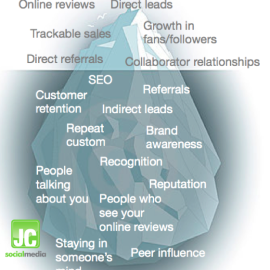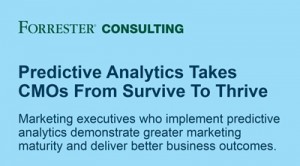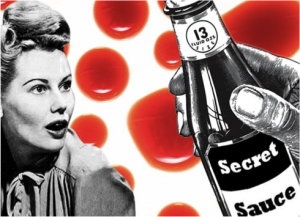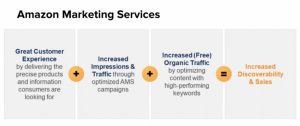By Jodie Cook, Published November 1, 2014
We’re addressing the subject on most people’s minds when it comes social media marketing – what’s the ROI of social media? It’s a completely valid question and one that no one should shy away from! Companies part with hundreds of thousands of pounds on billboard advertising over a motorway and have virtually no idea of the ROI, even if the billboard company says 60,000 drivers pass under it every day. It’s great brand exposure, right?
We’re going to help unpick the mystery of the ROI of social media.
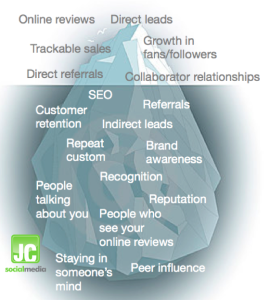 Like many other forms of marketing, there is an ‘iceberg effect’ (see picture) in terms of what we can measure and what effect we’re estimating but by no means is social media this ‘black box’. Naturally, the ROI of your social media marketing is going to be determined by what the goals of the campaign or general activity are but we’ll focus on some key indicators.
Like many other forms of marketing, there is an ‘iceberg effect’ (see picture) in terms of what we can measure and what effect we’re estimating but by no means is social media this ‘black box’. Naturally, the ROI of your social media marketing is going to be determined by what the goals of the campaign or general activity are but we’ll focus on some key indicators.
Measuring the ROI of social media
Using a combination of social media tools and Google analytics, here are some of the things we can measure.
- The ‘reach’ or number of impressions made by each post or post in total
- Interaction with posts including clicks on links and images
- Number of clicks to the website and which pages people landed on (and stayed on)
- Purchases made directly from Facebook (using Shopify or alike)
- Individuals communicated with over Twitter
- Handovers of leads from Twitter
- Offer or voucher codes to be redeemed in store/online
- Where did you find out about us? field on online forms or other feedback
Remember, if you have data on your conversion rates for hits to the website and/or certain pages, you’ll be able to estimate the revenue generated from social media. Arguably, because of the targeted and personal nature of social media marketing, conversion rates should be higher from social media platforms. Recording what happened with leads handed over will give a very accurate indication of ROI as well as sales on Shopify. In terms of impressions and reach, these give tangible measures on what will ultimately be the rest of the iceberg. This is akin to billboard or newspaper advertising and the tracked phone numbers or codes help measure the ROI in these instances.
The rest of the iceberg is going to be huge in most cases. This accounts for the improved brand perception, organic Google searches after someone saw a Facebook post or tweet. What about existing customers choosing to repeat buy because they saw a post they liked or were simply reminded of the brand? What about the positive conversations which happen offline between potential customers and collaborators?
What most companies (and even some social media agencies) fail to do is a) ascertain clear social media goals for their campaign and b) put the tools in place to be able to measure the metrics determined to be key performance indicators. If we can demonstrate a positive ROI on social media purely from the tip of the iceberg, think about all the other benefits.
The fact that social media marketing occurs digitally means there is actually far more scope to measure the ROI of social media than most traditional marketing methods. The issue to overcome is that 10,000 leaflets are 10,000 leaflets and to traditionalists, that represents tangible return on their spend, even before they’ve left the box! The problem is that the market is increasingly not engaged in the physical world and doesn’t appreciate such blatant marketing efforts. A well developed and delivered social media strategy will create positive ROI and a reputable social media agency will provide reports to show exactly what impact is being made.
Social Articles | Business 2 Community
(288)
